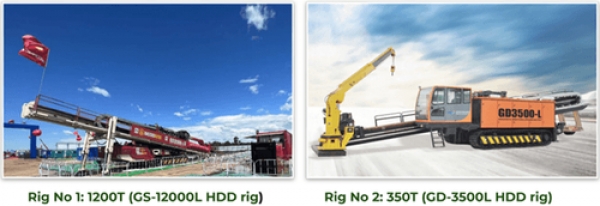In the world of large-scale infrastructure projects, certain milestones stand as defining moments, not only for the projects themselves but also for the teams that bring them to life. The AKK River Niger Crossing is one such defining achievement— an awe-inspiring example of overcoming immense technical, environmental, and logistical challenges to deliver a feat that will forever resonate in Nigeria’s energy infrastructure landscape. This journey is one of innovation, resilience, and an unwavering commitment to excellence.
When the AKK Project team embarked on the task of crossing the River Niger, it was more than just an engineering challenge—it was a test of leadership, collaboration, and vision. The doubts from both internal and external stakeholders were palpable. The OB3 Project had struggled with its own River Niger crossing, casting a shadow of skepticism over the AKK Project's ability to succeed. The fear of following in OB3’s footsteps was a constant presence. However, this story is not just about overcoming technical hurdles—it is about the strength of leadership, strategic decision-making, and the courage to pursue a new path when others would have chosen to follow the old one.
|
HDD Profile |
|
|
Pipeline Diameter |
40 inches |
|
Length |
1.56km |
|
Depth of Cover* |
15.97m |
|
Depth Below Riverbed |
9.49m & 6.75m |
|
Entry / Exit Angle |
8˚ / 6˚ |
|
* Distance from the surface of the water to the pipeline |
|
A Defining Moment: Bold Leadership Amidst Uncertainty
From the outset, the AKK Project team knew that to succeed, it had to break away from conventional approaches. The past challenges with the OB3 Project could not be ignored, and it became apparent that repeating the same method would likely result in another failure. Instead of simply acknowledging past mistakes, the team took decisive action: they sought out a global specialist to take on the River Niger crossing.
This decision, though difficult, was driven by one simple, yet powerful principle: where there is a will, there is always a way. The request to NNPC Top Management to approve direct subcontracting and step aside from the original plan to bring in a global consortium was not made lightly. Oilserv, the original EPC contractor, had already mobilized and was prepared to begin work using Direct Pipe Installation (DPI), a method previously used for such crossings. However, it was clear that the AKK Project could not afford another failure.
By engaging PCE Thailand and Lantic Industry Limited as the PCE Thailand-Lantic Consortium, the AKK Project team shifted from the DPI method to a more innovative and technically advanced solution— Horizontal Directional Drilling (HDD). This was not merely a tactical adjustment but a strategic pivot, driven by the understanding that only through cutting-edge technology and expertise could the River Niger crossing be completed successfully.
Strategic Stakeholder Engagement: Aligning Internal and External Forces
As with any high-stakes project, stakeholder engagement was key to ensuring success. The AKK Project team understood that managing relationships, both within and outside the organization, was vital to maintaining momentum and overcoming obstacles.
Internal Stakeholder Engagement
At the heart of the AKK Project’s success was the alignment between the project team and NNPC Top Management. The team's ability to keep leadership informed, engaged, and aligned with the project’s goals ensured that strategic decisions could be made promptly and decisively. Throughout the project, regular progress updates, meetings, and reports were provided, allowing NNPC Top Management to remain well-informed of the project’s challenges and successes. This transparency built trust and confidence, reinforcing the project’s credibility within the organization and demonstrating the team’s commitment to meeting the ambitious timelines.
A special appreciation is due to NNPC Top Management, whose unwavering support, strategic vision, and encouragement were critical to the project’s success. The Management’s resolve to steer the project through its challenges, coupled with their dedication to ensuring timely delivery, exemplified true leadership. Their confidence in the project team allowed for bold decisions to be made, including the pivotal step of subcontracting the River Niger crossing to PCE Thailand-Lantic Consortium.
External Stakeholder Engagement
Externally, the AKK Project team engaged with a variety of stakeholders, including local authorities, contractors, suppliers, communities and security forces. Each external stakeholder played a vital role in overcoming the logistical and security challenges faced during the project. Constant communication ensured that potential issues, such as delays in equipment delivery or customs clearance, were addressed promptly. This external collaboration helped maintain the project’s momentum and contributed significantly to the timely execution of the River Niger crossing.
Security Risk Mitigation: Security was, without a doubt, one of the most critical risks throughout the project. Lokoja, the site of the River Niger crossing, is in a region that has historically been prone to security risks, including incidents of banditry and kidnappings. The AKK Project team worked diligently with security agencies and stakeholders to develop a comprehensive security plan that ensured the safety of both personnel and equipment. Regular threat assessments, situational updates, and close collaboration with local law enforcement helped ensure a secure working environment. Furthermore, the integration of private security contractors and a dedicated security team helped mitigate the risk of disruptions and threats, allowing the project to progress without significant hindrances.
- Requirement to complete the crossing in 2025
- Subsurface variability, long distance, large pipe diameter
- Impending rains with annual flooding
- Quick mobilization of the necessary resources (Personnel and Equipment) to the construction site
- Relocation of the welded spool to the other side of the river
- Failure of initial pilot hole
The Race Against Time: Managing Time Constraints and External Risks
One of the most pressing risks throughout the AKK Project was the looming threat of the rainy season. Lokoja experiences seasonal flooding, and the peak of the rainy season occurs around August and September, leaving a narrow window for completing the crossing. Given the ambitious timeline set by NNPC Top Management for the completion of the mainline works by Q4 2025, the project team had to work with extreme urgency.
To mitigate this time constraint, the AKK Project team implemented a series of strategic decisions:
Rapid Equipment Mobilization: The project team worked closely with the Nigeria Customs Service and logistics providers to expedite the importation and clearance of equipment. This proactive approach ensured that the necessary materials were available on-site without delays.
24/7 Operations: To maximize the available weather window, the team operated around the clock. By working in continuous shifts, the team ensured that all activities were carried out without interruption, making the most of the dry season before the rains arrived.
HDD Intersect Method: The decision to adopt the HDD Intersect Method was pivotal in minimizing the time required for the crossing. This method, although more complex than traditional single-side drilling, allowed the team to drill from both banks of the river, converging in the middle. This innovative technique significantly reduced the amount of time needed to complete the crossing while simultaneously lowering the risks associated with long-distance drilling.
Lessons Learned: A Blueprint for Future Success
The AKK River Niger Crossing was not just a technical achievement; it was a showcase of world-class project execution. The lessons learned from this experience will serve as a model for future projects, not only in Nigeria but across the world. Below are the key lessons that emerged from the project.
Stakeholder Engagement is Vital: Maintaining open and transparent communication with both internal and external stakeholders is crucial for ensuring alignment, managing expectations, and keeping the project on track.
Proactive Risk Management: Identifying potential risks early and developing comprehensive mitigation strategies is critical for overcoming obstacles. The AKK Project demonstrated how foresight and planning could minimize the impact of security, logistical, environmental, financial and stakeholders’ risks.
Leadership and Strategic Decision-Making: The project’s success was driven by bold leadership and the courage to make difficult decisions. The willingness to step away from established plans in favor of innovative solutions allowed the AKK Project to turn challenges into opportunities.
Collaboration Across Disciplines: The project was a collaborative effort involving multidisciplinary teams from engineering, procurement, construction, logistics, security, HSE, and management. This collective approach ensured that all aspects of the project were executed seamlessly, resulting in the successful completion of the River Niger crossing.
Flexibility and Adaptability: The ability to adapt to unforeseen challenges, such as the failure of the initial pilot hole, was instrumental in the project’s success. Flexibility in decision-making and problem-solving allowed the team to stay on track despite setbacks.
Acknowledging Leadership: A Tribute to NNPC and NGIC Top Management
None of the success achieved in the AKK River Niger Crossing would have been possible without the visionary leadership and steadfast support of both NNPC Top Management and NGIC Top Management. Their encouragement, resolve, and strategic oversight provided the foundation upon which this success was built.
NNPC Top Management’s constant encouragement, support, and leadership were key to the project’s success. Their commitment to ensuring that the AKK Project achieved its objectives, even in the face of uncertainty, is a testament to their dedication to national progress. The Management’s clear direction, paired with their timely decision-making, enabled the team to tackle challenges head-on with confidence.
NGIC Top Management’s unwavering support, from day one, was critical in driving the project forward. Their proactive involvement in steering the team, providing financial resources, and facilitating smooth operations was integral to overcoming obstacles and achieving this historic feat. The collaborative spirit displayed by NNPC Top Management and NGIC Top Management set the tone for the entire project team, fostering a sense of unity and purpose that played a crucial role in ensuring success.
The Road Ahead: Paving the Future of Nigeria’s Energy Landscape
With the completion of the AKK River Niger Crossing, the project is poised to meet its final milestones and deliver critical infrastructure that will serve Nigeria for decades to come. This achievement, underpinned by strategic thinking, bold leadership, and an unwavering commitment to excellence, stands as a beacon for future infrastructure projects in the region.
The lessons learned from this project, combined with the exemplary leadership of NNPC and NGIC, will continue to shape the future of Nigeria’s energy and infrastructure landscape. As the AKK pipeline nears completion, the success of the River Niger crossing marks a pivotal moment in the realization of a brighter, more sustainable energy future for Nigeria.
Credit: NNPC

